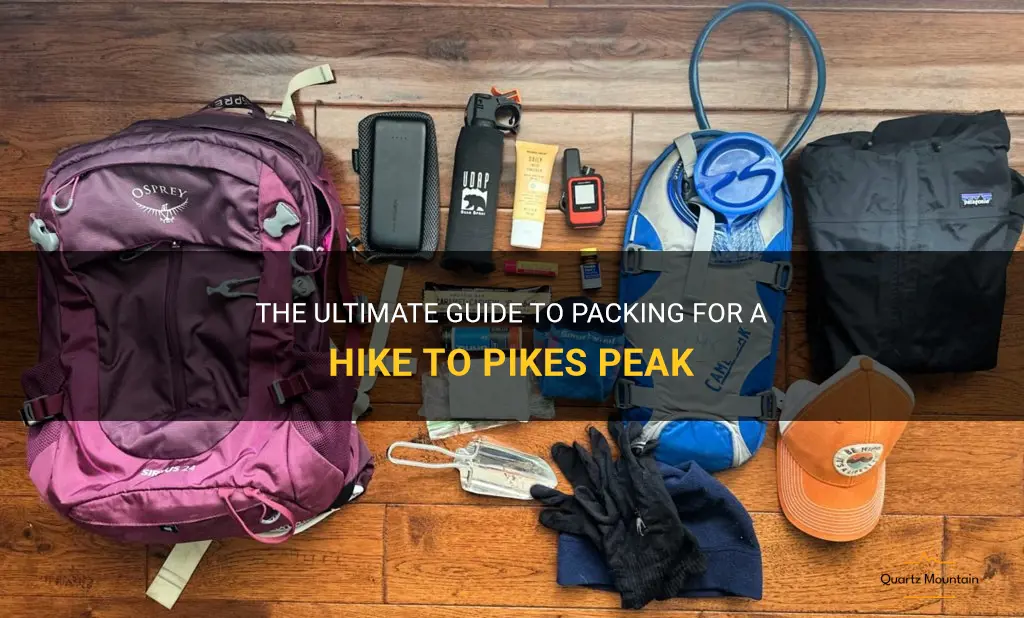
If you're gearing up for an epic hiking adventure to the majestic Pikes Peak, then you're in for a treat. This towering mountain in Colorado offers breathtaking views and challenging trails that will test your endurance and push you to new heights. But before you embark on this adventure of a lifetime, you'll need to pack smartly. In this ultimate guide, we'll cover everything you need to know about packing for a hike to Pikes Peak. From essential gear to packing tips and tricks, we've got you covered. So grab your backpack and get ready for an unforgettable journey to one of nature's most stunning wonders.
| Characteristics | Values |
|---|---|
| Elevation | 14,115 feet (4,302 meters) |
| Difficulty Level | Strenuous |
| Distance | Varies depending on the route, but averages around 12 miles round trip |
| Duration | Full day or overnight |
| Weather | Unpredictable, can change rapidly. Prepare for hot sun, cold temperatures, high winds, and potential thunderstorms |
| Clothing | Layers (long sleeve shirt, jacket, hat, gloves), sturdy hiking boots, hiking socks |
| Food and Water | At least 2 liters of water per person, high-energy snacks, packed lunch |
| Backpack | Daypack or backpack with chest and waist straps for support |
| Navigation | Map, compass, GPS, trail markers, trail guide or map app |
| First Aid Kit | Bandages, antiseptic ointment, pain relievers, blister treatment, insect repellent |
| Sun Protection | Sunscreen, sunglasses, wide-brimmed hat |
| Emergency Supplies | Headlamp or flashlight, whistle, space blanket, extra layers |
| Communication | Cell phone with fully charged battery, emergency contact information |
| Others | Trekking poles, camera, binoculars, cash for trail fees or services |
| Camping Gear (if overnight) | Tent, sleeping bag, sleeping pad, camp stove, food storage containers, cooking utensils |
What You'll Learn
- What essential items should I pack when hiking Pikes Peak?
- How much water should I bring for a hike up Pikes Peak?
- Is it necessary to pack extra layers of clothing for unpredictable weather on Pikes Peak?
- Are there any specific food or snacks that are recommended for a hike up Pikes Peak?
- Are there any specific hiking gear or equipment that I should bring for a hike up Pikes Peak?

What essential items should I pack when hiking Pikes Peak?
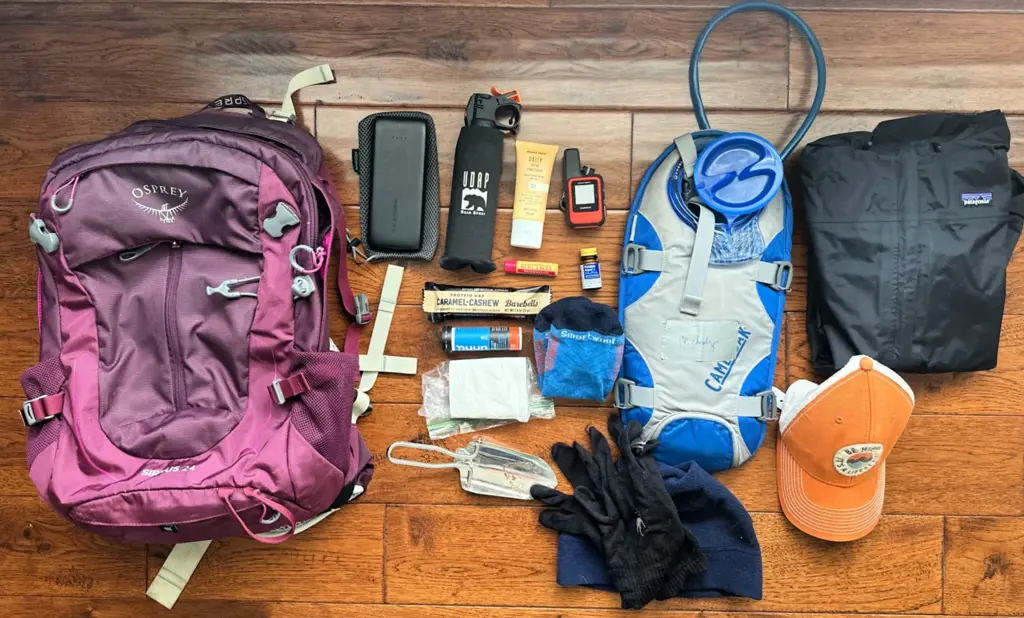
When preparing for a hike up Pikes Peak, it is important to pack the right gear and essential items to ensure a safe and enjoyable journey. Pikes Peak is a challenging hike with changing weather conditions and rugged terrain, so it is crucial to come well-prepared.
One of the most important items to bring is proper footwear. Hiking boots that provide ankle support and have good traction are essential for navigating the rocky trails of Pikes Peak. Wearing the wrong shoes can lead to discomfort, blisters, or even injury. It is also a good idea to break in your boots before attempting the hike to avoid any discomfort during the journey.
Carrying enough water is crucial for staying hydrated during the hike. It is recommended to bring at least two liters of water per person, as the hike can be strenuous and altitude can contribute to dehydration. It is also useful to bring a water purification system or water filters in case you need to refill from natural sources along the trail.
Food and snacks are important for refueling your energy during the hike. Pack lightweight and high-energy snacks such as trail mix, energy bars, and jerky. It is advisable to bring enough food to last the duration of your hike, as there might not be any food options available along the trail.
Weather can change rapidly on Pikes Peak, so it is crucial to pack appropriate clothing. Layering is key, as it allows you to adapt to changing conditions. Bring a lightweight and moisture-wicking base layer, insulating layers such as a fleece or down jacket, and a waterproof and windproof outer layer. Don't forget to pack a hat, gloves, and sunglasses to protect yourself from the sun and wind.
Navigational tools are essential for a successful hike. A reliable map and compass, or a GPS device, can help you stay on the right trail and avoid getting lost. Make sure to familiarize yourself with the route beforehand and carry a detailed trail map.
A first aid kit is a must-have item when hiking Pikes Peak. Include essential items such as bandages, adhesive tape, pain relievers, blister treatments, and any personal medications you might need. It is also a good idea to bring a whistle, flashlight, and fire-starting tools for emergency situations.
Other essential items to pack include sunscreen, insect repellent, a lightweight backpack with a rain cover, trekking poles for added stability, and a camera to capture the breathtaking views.
In conclusion, packing the right gear and essential items is crucial when hiking Pikes Peak. Proper footwear, enough water, food, appropriate clothing, navigational tools, a first aid kit, and other necessary items will ensure a safe and enjoyable journey. It is always better to be over-prepared than under-prepared when taking on the challenges of Pikes Peak. Remember to check the weather forecast before heading out and adjust your packing accordingly. Happy hiking!
Essential Items to Pack for Medical School in the Caribbean
You may want to see also

How much water should I bring for a hike up Pikes Peak?
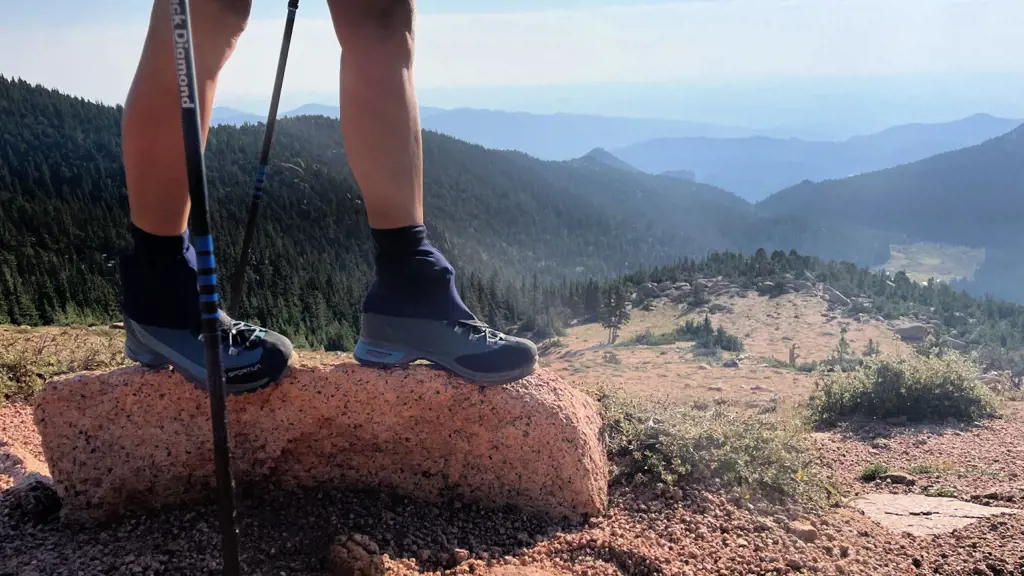
Hiking up Pikes Peak, one of the most popular fourteeners in Colorado, can be an exciting and rewarding experience. However, it is essential to come prepared and ensure you have enough water to stay hydrated throughout the hike. So, how much water should you bring for a hike up Pikes Peak?
The answer to this question depends on a few factors such as the weather conditions, your level of physical fitness, and the length of the hike. On average, it is recommended to bring at least one liter of water per hour of hiking, especially in hot and dry conditions. For a conservative estimate, a 10-mile hike up Pikes Peak can take anywhere from 6 to 10 hours, so having 6 to 10 liters of water with you would be a good starting point.
It is essential to note that this is a general guideline, and individual needs may vary. Factors such as your body weight, sweat rate, and tolerance to dehydration play a role in determining how much water you should bring. To have a more accurate estimate, you could calculate your sweat rate by weighing yourself before and after a shorter hike, measuring how much weight you have lost (1 liter of water weighs about 2.2 pounds). This will give you an idea of how much water you might need to replace during a longer and more strenuous hike like Pikes Peak.
Furthermore, it is crucial to consider the availability of water sources along the trail. While Pikes Peak does have a few creeks and streams, it is not advisable to rely solely on them for your water supply. Water from natural sources may contain harmful bacteria, viruses, or parasites, which can lead to gastrointestinal issues and other health problems. Therefore, it is recommended to bring your own water or use a water filter or water purification tablets to make natural water sources safe to drink.
In addition to staying hydrated, it is vital to replenish electrolytes lost through sweat during your hike. Electrolytes are minerals such as sodium, potassium, and magnesium that help regulate fluid balance in the body. When you sweat, you lose these electrolytes and need to replace them to maintain proper hydration levels. Consider bringing electrolyte-rich drinks or snacks along with your water to ensure you stay properly hydrated and minimize the risk of dehydration or heat-related illnesses.
Lastly, it is essential to listen to your body and pay attention to signs of dehydration or overhydration during your hike. Symptoms of dehydration include dry mouth, thirst, fatigue, dizziness, and decreased urine output. On the other hand, overhydration can lead to hyponatremia, a condition where the concentration of sodium in your blood is abnormally low. Symptoms of hyponatremia include headache, nausea, confusion, seizures, and in severe cases, coma. Finding the right balance between staying hydrated and not overdoing it is crucial for a successful hike up Pikes Peak.
To sum it up, when planning a hike up Pikes Peak, it is crucial to bring enough water to stay hydrated throughout the journey. Aim to bring at least one liter of water per hour of hiking, considering factors such as weather conditions, hike duration, and individual hydration needs. Additionally, be prepared by bringing your own water and considering electrolyte replenishment. By staying properly hydrated, you can enjoy the beautiful scenery and conquer the summit of Pikes Peak with ease and safety.
The Ultimate Guide: How to Choose the Perfect Bag for Burning Man
You may want to see also

Is it necessary to pack extra layers of clothing for unpredictable weather on Pikes Peak?
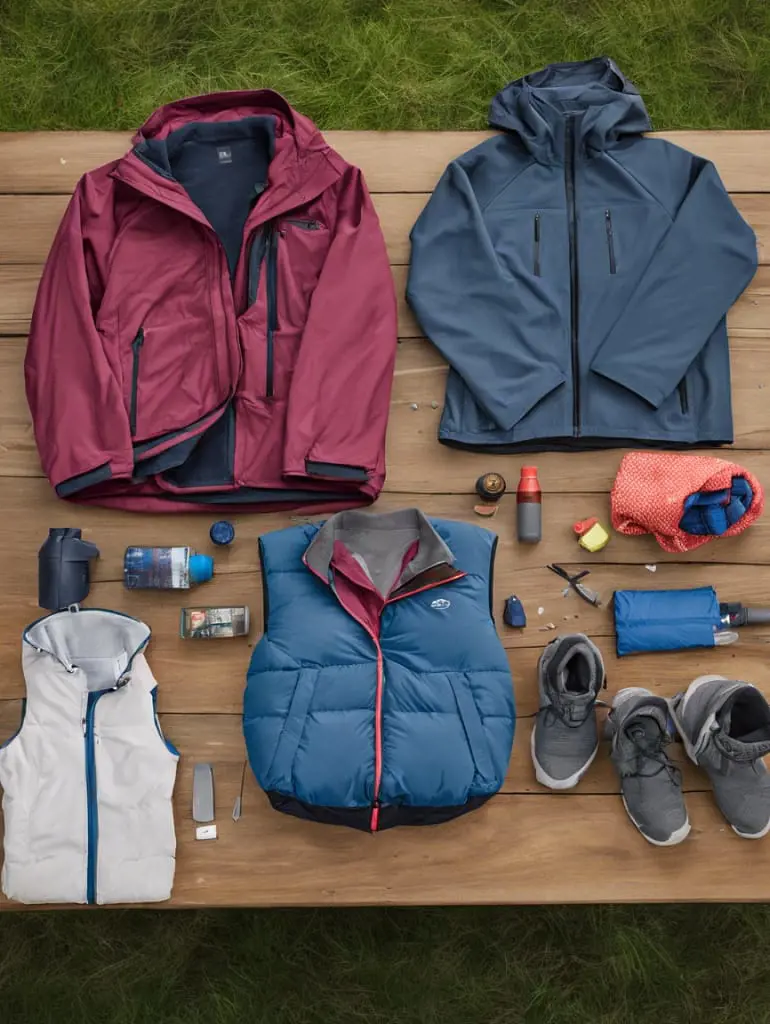
Pikes Peak, located in Colorado, is a popular destination for outdoor enthusiasts and nature lovers. It is known for its stunning panoramic views and unpredictable weather conditions. At an elevation of over 14,000 feet, the weather on Pikes Peak can change rapidly, even in the summer months. This leaves many visitors wondering if it is necessary to pack extra layers of clothing to prepare for the unpredictable weather.
The short answer to this question is yes, it is highly recommended to pack extra layers of clothing when visiting Pikes Peak. The main reason for this is the significant changes in temperature and weather conditions that can occur throughout the day. Even in the summer, temperatures can drop below freezing, and snowstorms can occur unexpectedly. It is not uncommon to experience sunshine, rain, and snow all in the same day on Pikes Peak.
The decision to pack extra layers of clothing is grounded in both scientific understanding and experiences of hikers and mountaineers who have visited Pikes Peak. The elevation of Pikes Peak means that the air is thinner and colder, making it important to dress in layers to regulate body temperature effectively. The base of the mountain may be warm and sunny, but as you ascend, the temperature can drop considerably. Wind chill can also make the temperature feel much colder than it actually is, especially on exposed areas of the mountain.
Dressing in layers is a proven method for managing body temperature in changing weather conditions. By wearing multiple thin layers, you can add or remove clothing as needed to maintain a comfortable body temperature. This allows you to adapt to the changing weather conditions on Pikes Peak throughout the day. It is also essential to choose clothing made from moisture-wicking and insulating materials to keep you dry and warm.
To better illustrate the importance of packing extra layers of clothing, let's consider a scenario. You start your hike in the morning, and the weather is warm and sunny. As you ascend, you start to feel a drop in temperature and notice clouds forming overhead. Within a few hours, the weather turns cloudy, and a light rain begins to fall. Without proper layers, you may become wet and cold, which can lead to discomfort and potentially dangerous situations if the weather worsens. However, if you have packed extra layers, you can easily add a rain jacket or a fleece to stay dry and warm.
Additionally, it is important to consider the potential dangers of hypothermia when visiting Pikes Peak. Hypothermia occurs when the body loses heat faster than it can produce it, resulting in a dangerously low body temperature. The combination of cold temperatures, wind chill, and wet clothing can increase the risk of hypothermia. Packing extra layers of clothing can act as an added layer of protection against this risk.
In conclusion, it is highly advisable to pack extra layers of clothing when visiting Pikes Peak due to its unpredictable weather conditions. The scientific understanding of changing temperatures at higher elevations, coupled with the experiences of hikers and mountaineers, demonstrates the necessity of dressing in layers to regulate body temperature effectively. By packing extra layers, you can adapt to the changing weather conditions and ensure your comfort and safety during your visit to Pikes Peak. So, next time you plan a trip to Pikes Peak, don't forget to pack those extra layers! Your body will thank you.
Essential Items to Pack for a 6-Day Trip
You may want to see also

Are there any specific food or snacks that are recommended for a hike up Pikes Peak?
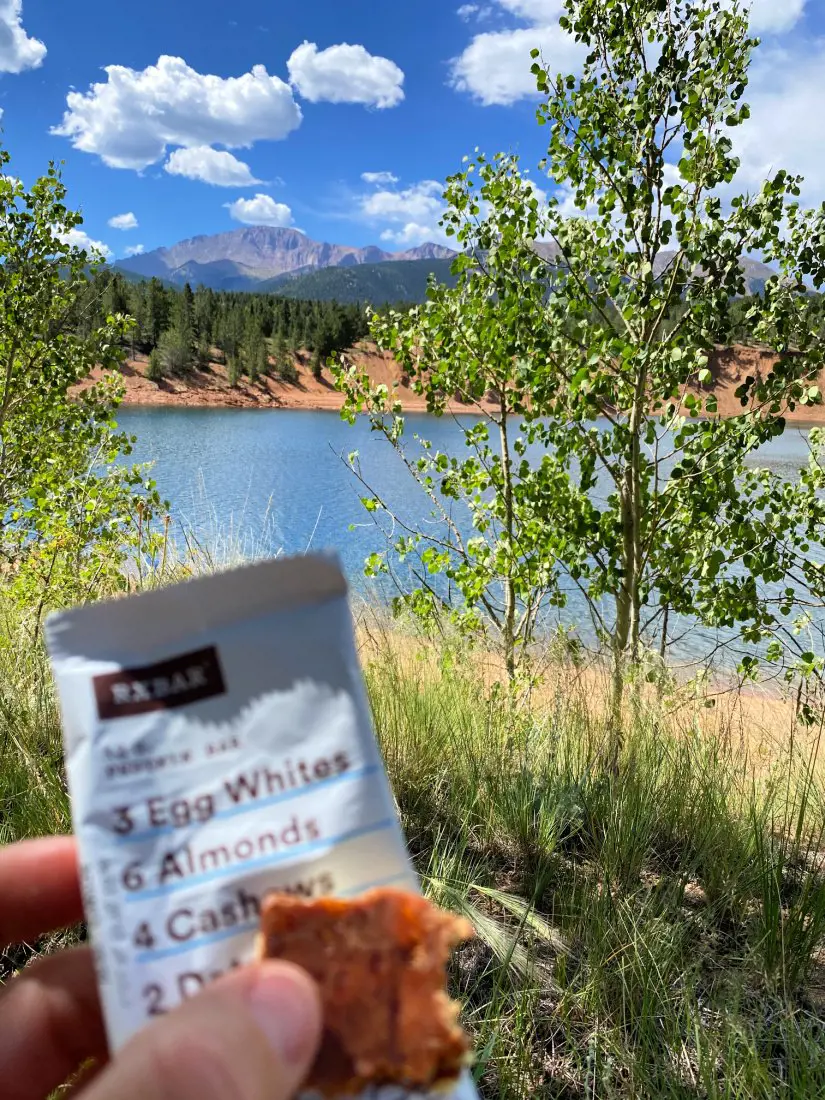
Hiking up Pikes Peak is a thrilling adventure that can take several hours, so it's important to fuel your body properly. Packing the right food and snacks for your journey will keep you energized and ensure a successful hike. Here are some recommendations for specific foods and snacks that are ideal for a hike up Pikes Peak.
- Carbohydrates for sustained energy: Carbohydrates are essential for providing the energy you need to keep going during a long hike. Opt for complex carbohydrates such as whole grain bread, pasta, or oats. These foods provide a steady release of energy, helping to prevent energy crashes.
- Protein for muscle repair: Protein is important for repairing and building muscles, which can be beneficial during a strenuous hike. Pack protein-rich snacks such as nuts, trail mix, beef jerky, or protein bars. These compact and lightweight options are easy to carry and offer a good balance of nutrients.
- Fruits and vegetables for hydration and nutrients: Fruits and vegetables are packed with essential vitamins, minerals, and antioxidants. They also provide hydration, which is crucial during a hike to keep your body functioning properly. Apples, oranges, bananas, carrots, and cucumber slices make excellent portable options.
- Healthy fats for sustained energy: Including healthy fats in your hiking snacks can help provide a slow release of energy and keep you feeling satiated. Nuts, nut butter, avocado, and seeds are all great sources of healthy fats. These snacks are lightweight, easy to pack, and provide a good source of calories to keep you going.
- Electrolyte-rich snacks for hydration: Electrolytes are minerals that help regulate fluid balance, nerve function, and muscle contractions. Sweating during a hike can cause electrolyte imbalances, so it's important to replenish them. Pack electrolyte-rich snacks such as sports drinks, electrolyte tablets, or coconut water to stay hydrated and prevent cramping.
- Portable and lightweight snacks: When hiking, it's crucial to pack lightweight and portable snacks that won't weigh you down or take up too much space in your backpack. Consider individual packets of nut butter, granola bars, energy gels, or dried fruits. These snacks are convenient and won't spoil easily.
It's important to note that everyone's nutritional needs may vary, so it's best to listen to your body and pack snacks that work well for you. It's also crucial to stay hydrated throughout your hike by carrying an adequate amount of water or a water filtration system.
In conclusion, when hiking up Pikes Peak, it's recommended to pack a variety of foods and snacks that provide sustained energy, hydration, and essential nutrients. Carbohydrates, protein, fruits, vegetables, healthy fats, electrolytes, and portable snacks are all excellent choices to fuel your body and enhance your hiking experience. Remember to pack enough water and listen to your body's hunger and thirst cues to ensure a safe and enjoyable hike.
Pack for Paradise: Essential Items for Bermuda in December
You may want to see also

Are there any specific hiking gear or equipment that I should bring for a hike up Pikes Peak?
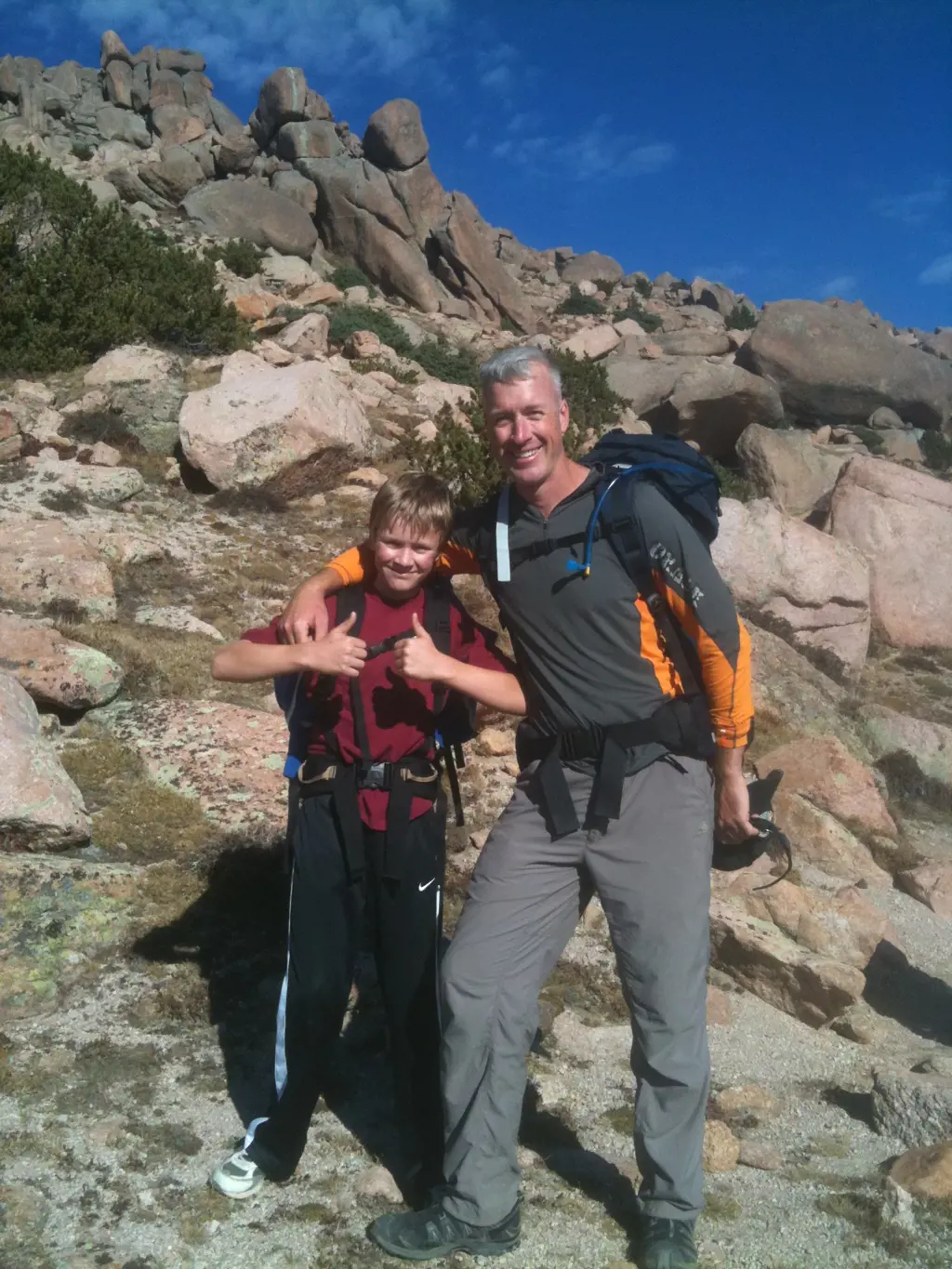
If you are planning to hike up Pikes Peak, one of Colorado's most iconic fourteeners, you must be prepared with the right gear and equipment. Hiking at high altitudes can be challenging, and having the right gear can make your experience safer and more enjoyable. Here are some essential items to bring for a hike up Pikes Peak:
- Hiking Boots: Invest in a good pair of hiking boots that offer ankle support and traction. The trails on Pikes Peak can be rocky and uneven, so having sturdy footwear is crucial for stability and preventing injuries.
- Layered Clothing: The weather on Pikes Peak can change rapidly, even during the summer months. It is important to dress in layers, so you can adjust your clothing based on the temperature and weather conditions. Start with a moisture-wicking base layer, add a mid-layer for insulation, and bring a waterproof or windproof outer layer.
- Backpack: Choose a backpack that is comfortable and spacious enough to carry all your essentials. Look for one with adjustable straps and multiple compartments to keep your gear organized. Your backpack should also have a hydration system or space for water bottles to ensure you stay hydrated throughout your hike.
- Navigation: Although the trails on Pikes Peak are well-marked, it is still a good idea to bring a map, compass, or GPS device. Familiarize yourself with the route before your hike and have a backup navigation tool in case of technological failures.
- Water and Snacks: Staying hydrated and fueled is crucial during a hike. Bring enough water to last the entire duration of your hike, and pack nutrient-rich snacks such as energy bars, trail mix, or dried fruits. Avoid heavy or perishable items that might weigh you down or spoil.
- Sun Protection: The higher elevation of Pikes Peak means increased sun exposure and higher UV radiation levels. Protect your skin by wearing sunscreen with a high SPF, a wide-brimmed hat, and sunglasses. Don't forget to reapply sunscreen throughout the day.
- First Aid Kit: Accidents can happen, so it is important to carry a basic first aid kit. Include items such as band-aids, blister pads, antiseptic wipes, pain relievers, and any necessary personal medication. Also, pack a small emergency blanket and a whistle in case of emergencies.
- Trekking Poles: Trekking poles can provide extra stability, especially during steep ascents or descents. They can help reduce strain on your knees and improve your balance. Consider using collapsible trekking poles so you can easily pack them away when not in use.
- Headlamp: If you are planning to hike during the early morning or late afternoon, a headlamp is essential. It will help you navigate the trail when visibility is low and ensure your safety in case you end up hiking after dark.
- Camera: Lastly, don't forget to bring a camera to capture the breathtaking views from Pikes Peak. Whether you use a smartphone or a dedicated camera, having a way to document your adventure will allow you to cherish the memories for years to come.
Remember, proper preparation and having the right gear are essential for a successful hike up Pikes Peak. Before your hike, familiarize yourself with the trail conditions, check the weather forecast, and inform someone about your plans. With the right gear and precautions, you can have a memorable and safe hiking experience on Pikes Peak.
Essential Items to Pack for Rio Carnival: Your Complete Guide
You may want to see also
Frequently asked questions
When hiking Pikes Peak, it's important to pack essential items such as a map and compass for navigation, plenty of water and high-energy snacks, a first aid kit for any emergencies, sunscreen and sunglasses for sun protection, extra clothing layers for changing weather conditions, and sturdy hiking boots for comfort and support.
While special gear may not be required for hiking Pikes Peak, it is recommended to have a backpack with good storage capacity to carry all your essentials, trekking poles for better balance and support on this challenging hike, and a headlamp or flashlight in case you end up hiking in the dark. It's also important to have a quality backpacking tent and sleeping bag if you plan to camp overnight on the mountain.
When dressing for hiking Pikes Peak, it's important to wear layered clothing. Start with a moisture-wicking base layer, add insulating layers like a fleece or down jacket, and top it off with a waterproof and windproof outer layer. Make sure to wear proper hiking socks and choose boots that are comfortable, well-fitting, and provide ankle support. Don't forget to bring a hat, gloves, and extra socks in case of unexpected weather changes.
Yes, it is crucial to bring enough food and water for hiking Pikes Peak. Plan to bring at least 2-3 liters of water per person to stay hydrated throughout the hike. High-energy snacks such as trail mix, energy bars, and fresh fruit are great for providing fuel and keeping your energy levels up during the long hike. Additionally, consider bringing a lightweight camping stove and dehydrated meals if you plan to camp overnight on the mountain.







